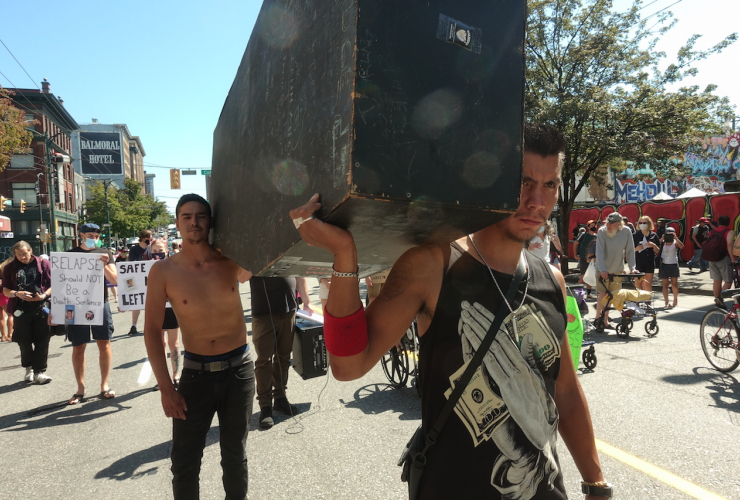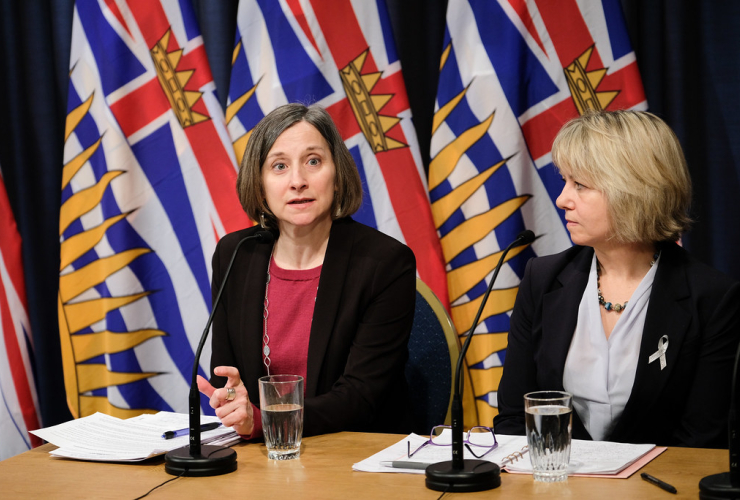As the death toll from illicit drug overdoses continues to mount unabated in B.C., advocates want more specialized services and harm reduction measures to help protect young people.
Another 162 fatalities occurred in October due to toxic drug supply, for a total of 1,386 deaths in 2020, according to the BC Coroners Service's most recent figures.
Of those killed this year by the overdose crisis, 19 per cent, or 269 deaths, were young people aged 29 years old or younger, with 14 of the dead under the age of 19, the coroners service figures show.
Kali Sedgemore, a youth outreach worker and peer harm reduction advocate in Vancouver, said the ongoing public health emergency is in its fifth year, and COVID-19 is only exacerbating the harms.
“We don’t even have time to grieve because we know we will hear about another (death) the next day,” Sedgemore said.
The dangers of the toxic illicit drug supply are being compounded as people following pandemic protocols use illicit drugs alone and as harm reduction services have been reduced, or wait times have increased at overdose prevention sites (OPS) during the pandemic, Sedgemore added.
Youth do not make up the largest number of fatalities, but all overdose deaths are largely unnecessary and preventable, Sedgemore said.
In 2020, 70 per cent of those who have died from the toxic drug supply fall between the ages of 30 and 59, and males account for 80 per cent of the deaths to date. Most overdose fatalities involved people dying alone indoors.
One immediate way to reduce the harms from toxic illicit drugs to youth is to provide harm reduction and OPS services dedicated strictly to their demographic, Sedgemore said.
“Youth are vulnerable to manipulation by adults,” Sedgemore said, adding young people are at risk of being exploited sexually or for money or other reasons.
Specialized harm reduction services are already hard to come by in urban areas such as Vancouver but are even more scarce in smaller communities and rural areas, Sedgemore said, noting they originally came from a small community from the northern part of Vancouver Island.
Plus, young people — especially those under the age of 18 — are often deterred from using harm reduction services or supplies by providers due to their age, or can come under increased scrutiny from staff at these locations, they said.
Both of these situations make youth uncomfortable, Sedgemore said.
It’s also critical that medical professionals, social workers or other service providers don’t push youth into treatment before they are ready, Sedgemore stressed.
Doing so only puts youth at increased risk, forcing them to be more secretive about any illicit drug use and increasing the unwillingness to use harm reduction services or call emergency services in case of an overdose.
Research shows abstinence education, or the "just say no to drugs" approach, is not as effective as talking openly about illicit drugs, the associated risks and, if youth should choose to use them, how to do it safely, Sedgemore said.
However, there is also the need for more youth treatment beds and shorter wait-lists for youth seeking help, Sedgemore said, especially closer to their own communities.
“I don’t think it’s great sending a youth away from their own hometown and the people youth are used to seeing every day.”
Provincial response to stem youth overdoses
The B.C. government plans to double the number of treatment beds for youth aged 12 to 24 who are struggling with substance use.
A total of 60 young people under the age of 24 lost their lives to fentanyl poisoning from toxic street drugs from January to June 2020, according to the Ministry of Mental Health and Addictions.
The province committed $36 million to create another 123 treatment beds for young people, in addition to 20 beds recently established at a new youth facility in the Fraser Valley. Prior to the recent announcements, B.C. had 103 treatment beds for youth.
The new beds are part of a broader continuum of care the B.C. government is planning for young people that will include culturally safe, youth-specific services in both rural and smaller city centres, the ministry stated.
Building on its network of youth-specific mental health and substance use services, the province will develop eight new Foundry centres, for a total of 19 youth hubs.
Foundry centres provide primary care, youth and family peer supports, walk-in counselling, mental health and substance use services and social services all under one roof.
Youth in small cities, rural communities also at risk
Steve Ayers, program manager for the Foundry located in Campbell River on Vancouver Island, agreed that youth benefit from specialized services and being in charge of any decisions about their drug or alcohol use.
“If a counsellor is going to really be impactful, they have to let the client drive the process of making changes around substance use,” Ayers said.
“The objective of substance use counselling is to help youth have a better life, and what are some concrete ways that might happen, depending on their choices of course,” he said.
Many youth use substances to deal with trauma or anxiety, so alternate tools or strategies need to be developed to help young people deal with that suffering, he added.
It’s dangerous to assume youth overdoses due to illicit drugs are only a big-city problem, Ayers said.
“It’s absolutely a misconception,” he said, adding the issues that fuel youth substance use exist in every community across Canada.
However, youth generally don’t tend to be as entrenched with illicit hard drugs as some other age demographics, especially in rural areas where supply might be limited, Ayers said.
“If there’s no supply (of illicit drugs) kids will find other things to do to cope with what they are struggling with,” he said.
However, kids and families in rural or remote communities such as the Discovery Islands or small communities across North Vancouver Island can face additional challenges or gaps in accessing supports, Ayers said.
Many Foundry services are now available online to try to mitigate the challenges for youth living in more isolated communities who need support, especially with travel limitations due to the pandemic, he said.
The youth hub also works with schools to meet with students during class time for those who have to bus in and out of Campbell River.
Young people and their families just need to reach out and the Foundry will try to find a fix for any stumbling blocks to service, Ayers said.
“We always seem to be able to find them and reach them with help,” he said.
“Unless they're just not reaching out at all. And honestly, those are the people that we’re scared for most.”
Rochelle Baker / Local Journalism Initiative / Canada's National Observer






Comments